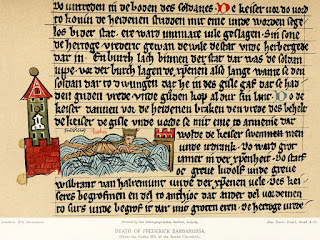His greatest legacy may be the Vita Columbae, the "Life of Columba." He was related on his father's side to St. Columba, and used an earlier source to write the definitive biography. The Life of Columba is a valuable resource for information about groups like the Picts, the practices of monasteries, and the politics of the time.
He also wrote De Locis Sanctis, "On Holy Places." He got the information second-hand by a Bishop named Arculf who visited Iona after being to the Holy Land, Egypt, Constantinople, and Rome.
He is also known for the Cáin Adomnán (Gaelic: "Canons of Adomnán"). Presented and agreed to in 697 at the Synod of Birr—a meeting of Irish nobles and churchmen believed to have been convened by Adomnán himself—it established the safety and immunity of non-combatants during war. It is also referred to in Latin as the Lex Innocentium, the "Law of Innocents."
As mentioned in the previous post, he makes one of the earliest references to the divine right of kings. Diarmait Mac Cerbaill was High King of Ireland; he died about 565. Adomnán said he was "ordained by God's will as king of all Ireland," and that his assassin was visited by divine punishment.
Adomnán died in 704, possibly on 23 September, which is celebrated as his feast day. Although the name Adomnán and its variants are rarely found today, his alternate name of Eunan is found on the Cathedral of Eunan and St. Columba in Letterkenny, County Donegal, as well as on other churches and schools.
I came to talk about Adomnán because of the link to the divine right of kings I wrote about yesterday, but the more I read, the more puzzling his example became. A monk declaring Diarmait Mac Cerbaill "ordained by God's will" looks more and more odd when you look at the king's actions: was he a Christian High King of Ireland, or was he a King of Tara, or both? We'll go into this tomorrow.














